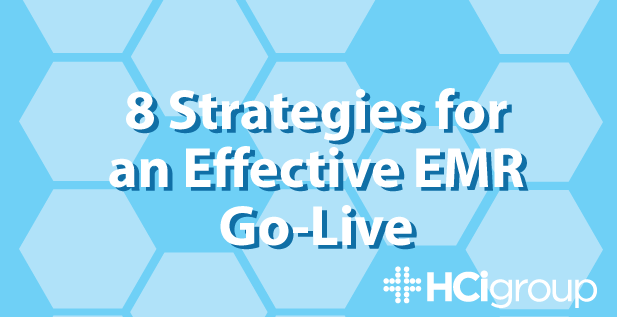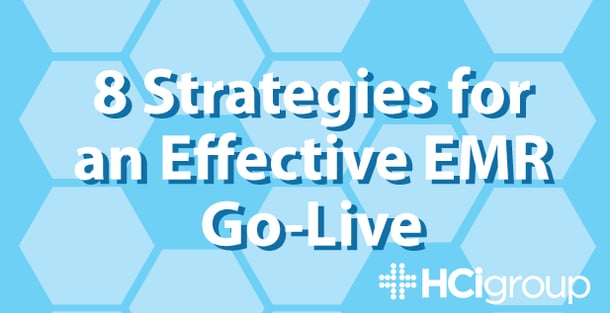8 Strategies for an Effective EMR Go-Live


An EMR implementation will transform your organization in many ways. Prior to go-live and eventual optimization, however, there are many steps that your organization must go through to ensure that your end users are all ready for the change. In this post, The HCI Group’s Executive Vice President Bob Steele takes us through the eight steps an organization will need to follow during Go-Live to achieve high end-user adoption rates and sustainment.
1) Having a Strategy and Advisory Team
One of the most important things an organization can do to ensure a successful Go-Live is to layout a well-planned strategy. After appointing a team and conducting a current state analysis, you can begin your readiness assessment. This assessment will help to determine whether or not your organization is ready for the changes that will soon be coming and can also help to discover any problems or gaps in workflow. By mapping out your implementation strategy – most importantly by clearly stating roles, goals for the implementation, and what you expect to gain – you give yourself a better understanding of how success will be defined during your Go-Live.
2) Communicating Effectively
In order for any major EHR implementation to be successful, it is vital that you communicate well within your organization. Daily shift change and town hall meetings are imperative to share status, successes, as well as critical/top issues, and the review of tip sheets or educational flashes. This process ensures that vital information is shared and the message is consistent to all staff and team members. The dissemination of this information will help avoid duplicate logging of known issues and corresponding prescribed resolutions or work arounds.
It is also important to monitor your ticket processing to make sure that questions can be answered in a timely fashion. By listening to which questions are being asked frequently, you can help find solutions to common problems in an efficient manner and work to prevent these tickets from coming in the first place.
3) Thorough On-Boarding Process
Your contracted resources must be required to undergo the same on-boarding requirements as facility employees. This may include, but is not limited to: Drug Screen testing, Criminal Background Checks, Immunization Status, Flu Shots, Single or Double Step PPD’s., etc. Ensuring your vendor partner is compliant with all required information and ready to submit it in an easily validated manner will save time and avoid last minute gaps in resource and support needs.
4) Having a Definitive Orientation Process
Your orientation process is a vital part of your Go-Live. During your orientation, you will give your entire organization a comprehensive idea of what you are planning to accomplish through Go-Live and how it will benefit you as a whole. By clearly stating your mission plan and the structure of your organization, employees will know how this plan is going to be put into motion. Through customized workflow reviews and customized orientation programs, they will also learn their role in making this vision come to life. Additionally, consider your vendor resources. Consistent information and training amongst both facility staff and “Guest Visitor Resources” is a must. Transparency is key! During a Go-Live, everyone is on the same team and should be on the same page. Keep in mind that for your external/vendor resources there are additional requirements that must be covered such as emergency code and drill information, fire and safety considerations, and HIPAA compliance. Your vendor partner will be happy to assist in ensuring compliance.

5) Scheduling Effectively
Guidance and support for department leads is essential as you identify and determine the number of super users for go-live. Regarding the common directive to provide one super user per unit, per shift—identifying one person for day shifts and one person for night shifts will lead to issues once you begin the actual scheduling. Remember that these super users are working 12 hour shifts multiple days a week. They should not be expected to work a 12-hour shift every day for 7 straight days. Additionally, having only super user for a night shift and one for a day shift may not be feasible depending on the unit, acuity, activity, and need to backfill. Be sure you have an accurate idea of the number of staff members you will need for 24/7 super user coverage, while avoiding staff burnout. This needs to be clearly articulated and understood to ensure that adequate support is available at go-live.
6) Activation
Finally! It is time for activation. A thorough, day-to-day activation plan is necessary and will help ensure that all of your hard preparation work translates into a smooth activation. Be sure to develop a ramp down strategy so that the external staff that helped you during your activation process can begin to taper. You must make sure that your organization’s staff is self-sufficient going forward on an operational basis. A detailed and concise “Cut-Over” plan and process must be in place. Ensuring that accurate and real time information is in the system and available for the Care Team is a major patient safety issue. A best practice is to develop a “Check Sheet” for every “In-Patient, In A Bed” to be completed between Midnight and 5 am. For a 7 am “Go-Live,” progress is assessed hourly per unit, and any issues or gaps are identified early and additional resources deployed as needed to ensure compliance and safety.
7) Measuring
The first few weeks are challenging! This is common in every facility and at every go-live. We have affected and changed the “Day in the life” of almost everyone in the facility. Monitoring and assessing analytics via reports is an excellent way to determine the “temperature or climate” of the change introduced. Feedback both positive and negative must be collected and collated. Requested enhancements should be logged and prioritized. A best practice is to clearly define a request process and appoint a “Change Control Board” to facilitate this process. Other than for Patient Safety and Financial/Regulatory identified issues, a moratorium on data base changes is common for the first 45-90 days after go-live. Give end-users the opportunity to get used to the system in current development and design prior to implementing any changes.
8) EMR Optimization
The steps you take to ensure the most efficient utilization your new EMR will be the focus of the optimization phase. During this phase, you can take the feedback that you have received on your new system and use it to re-design processes and workflows to better suit your users. Be prepared to make potential changes in management as well, if the situation calls for it. By planning for the on-going training needs of your new EMR, you can also make sure that new users can be integrated efficiently.
Additional Resources You May Be Interested In:
- eBook: The Definitive EHR Go-Live Guide
- Go-Live Support: Training and Super-User Support
- Go-Live Support: Pre & Post Go-Live
- Go-Live Support: Operation Communication
